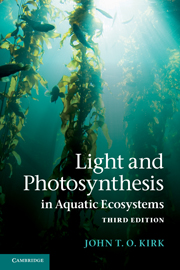Book contents
- Frontmatter
- Contents
- Preface to the third edition
- Part I The underwater light field
- Part II Photosynthesis in the aquatic environment
- 8 The photosynthetic apparatus of aquatic plants
- 9 Light capture by aquatic plants
- 10 Photosynthesis as a function of the incident light
- 11 Photosynthesis in the aquatic environment
- 12 Ecological strategies
- References and author index
- Index to symbols
- Index to organisms
- Index to water bodies
- Subject index
- Plate Section
11 - Photosynthesis in the aquatic environment
Published online by Cambridge University Press: 05 January 2013
- Frontmatter
- Contents
- Preface to the third edition
- Part I The underwater light field
- Part II Photosynthesis in the aquatic environment
- 8 The photosynthetic apparatus of aquatic plants
- 9 Light capture by aquatic plants
- 10 Photosynthesis as a function of the incident light
- 11 Photosynthesis in the aquatic environment
- 12 Ecological strategies
- References and author index
- Index to symbols
- Index to organisms
- Index to water bodies
- Subject index
- Plate Section
Summary
Having considered the photosynthetic response of aquatic plants to light of different intensities and spectral qualities, we shall now examine how the availability of light influences where, when and how much photosynthesis takes place in aquatic ecosystems, and also the extent to which other parameters of the environment can limit photosynthesis. Aquatic production ecology is an enormous field: a comprehensive account will not therefore be attempted. Rather, the broad principles governing the controlling influence of light and other parameters will be outlined and illustrated by examples. More detailed accounts and extensive bibliographies can be found in the books on phytoplankton ecology by Reynolds (1984), Harris (1986), and Fogg and Thake (1987), and the symposium proceedings edited by Platt and Li (1986), and Falkowski and Woodhead (1992). The essay by Fogg (1991) on ‘The phytoplanktonic way of life’ provides a particularly valuable overview of the multifarious interactions between the phytoplankton and its environment.
Circulation and depth
We saw in the previous chapter that except under very still conditions with virtually no wind or waves, there is always circulation of water in the upper layer. We also saw that this can be an advantage to the phytoplankton in so far as, by ensuring that they are not exposed to the intense light just below the surface for very long, they avoid photoinhibition. This circulation can, however, also be a disadvantage to the phytoplankton if, in the lower reaches of the mixed layer, the light intensity is too low for net photosynthesis to be achieved. As the depth of the mixed layer through which the phytoplankton is circulating increases, so the average light intensity to which the cells are exposed decreases, and consequently the total rate of photosynthesis by the whole phytoplankton population throughout the water column decreases. The rate of respiration of the whole phytoplankton population, on the other hand, will be essentially constant whatever the mixing depth. Thus, as was first pointed out by Braarud and Klem (1931), there exists a mixed-layer depth – the critical depth, zc – beyond which respiratory carbon loss by the whole population exceeds photosynthetic carbon gain, and so net phytoplankton growth cannot occur. Even when the critical depth is not exceeded, increases in mixing depth tend to reduce total photosynthesis.
- Type
- Chapter
- Information
- Light and Photosynthesis in Aquatic Ecosystems , pp. 388 - 452Publisher: Cambridge University PressPrint publication year: 2010
- 1
- Cited by



